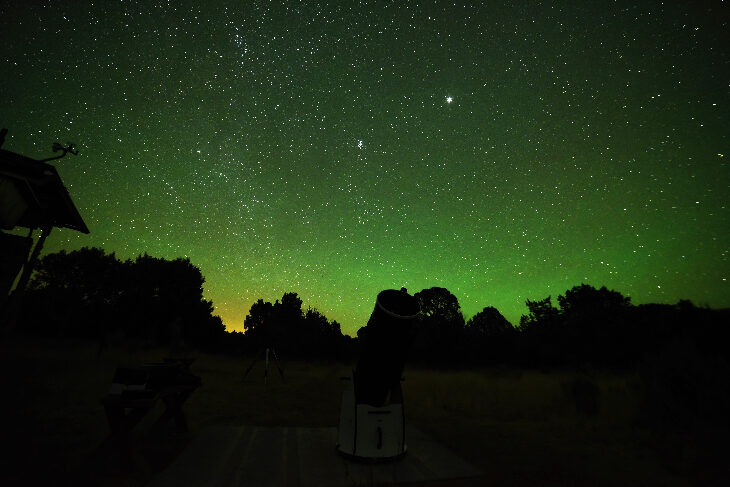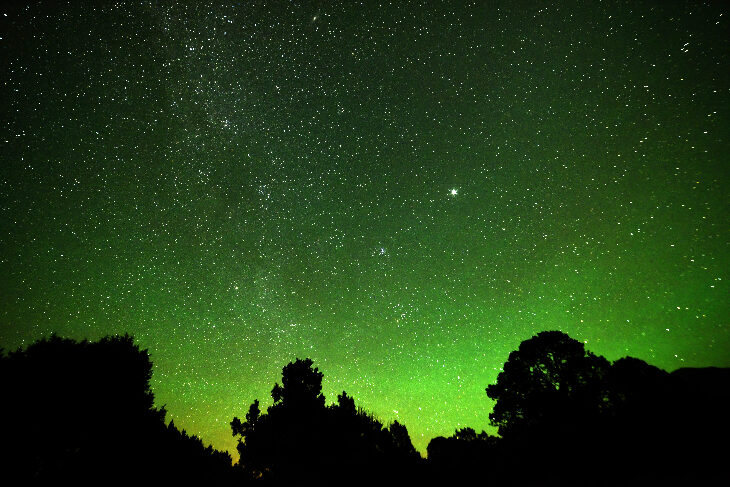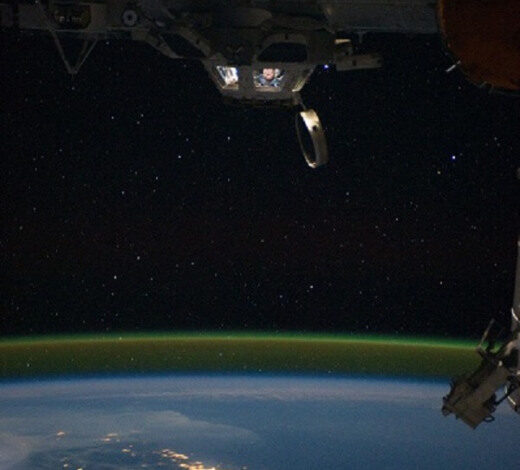
A phenomenon rarely seen in centuries might have just appeared in the night sky over Colorado--a "Bright Night." Philosophers and scientists have reported Bright Nights for literally thousands of years. It's when an otherwise dark and moonless night fills with a soft glow, allowing observers to see distant mountains or read a newspaper. Pliny the Elder, an Army commander in ancient Rome, described the phenomenon as a "nocturnal sun" (~ 113 BCE).
Comment: Pliny may, or may not, have been describing airglow: The Cosmic Context of Greek Philosophy, Part One
In the modern world, Bright Nights are seldom seen. Most of our planet's human population lives in cities, and even rural landscapes are somewhat lit by distant urban bulbs. The "nocturnal sun" has been overwhelmed.
Or has it? Enter Aaron Watson, an experienced night-sky photographer who regularly visits the darkest of dark-sky sites in remote parts of Colorado. On multiple occasions this year he has photographed red auroras and green airglow invisible from any ordinary countryside. Last month, he was at one of his favorite inky-dark sites when he may have experienced a modern Bright Night.
"I go outside on most clear nights to observe," says Watson, "but the night of Oct 9th was noticeably different. Although there was no Moon, or any other source of light, the landscape was softly illuminated. Nearby juniper trees made dark silhouettes against the glowing night sky. I could easily see my telescope and equipment. My partner was with me, and I could see her face quite well. I remarked, 'Wow, it's so bright out!' and she agreed."
"A 'Bright Night' sounds exactly like what I experienced!" says Watson.
As the landscape grew in brightness, Watson decided to photograph the sky. When he pointed his lens toward the stars, the viewscreen of his camera filled with green light. "It was a very strong green airglow--perhaps the brightest I have ever seen," he says. A 20 second exposure produced the photo shown above.
Bright Nights have been a mystery since at least the first century. Watson's photo could be a clue. It seems to confirm a hypothesis published in 2017 by Gordon Shepherd, then a professor at Canada's York University, who believed that Bright Nights were caused by intense displays of airglow.
Shepherd came to this conclusion using a satellite sensor he built himself: The Wind Imaging Interferometer (WINDII), which orbited Earth for 14 years onboard NASA's Upper Atmosphere Research Satellite. When he and co-author Youngmin Cho examined WINDII's archive, they found a number of apparent Bright Nights in the sensor's airglow data.
Airglow is just what it sounds like: A diffuse glow that fills the air. It is produced by photochemistry in Earth's upper atmosphere, with its green color coming from atomic oxygen. Frequently photographed by astronauts on the ISS, airglow can be detected by sensitive cameras on almost any dark night from all locations on Earth. Rarely, however, is it visible without a camera.
In their paper, Shepherd and Cho highlighted 11 events where WINDII detected airglow bright enough to see with the human eye. All were correlated with giant waves of high-altitude air called "zonal waves." Zonal waves are linked to Earth's jet stream, and play a crucial role in weather and climate. During the events Shepherd and Cho studied, zonal waves piled up ("constructively interfered") to create high pressure regions hundreds to thousands of miles wide. By forcing atomic oxygen into a higher concentration, the zonal waves created an intense Bright Night glow.
The amorphous glow in Watson's photo is just what one would expect of broad zonal wave activity. "The airglow was strong in all directions," recalls Watson. "It had a flat color density without ripples or other fine structures"--just as one would expect from Shepherd and Cho's hypotheses.
Bright Nights might not be a thing of the past, after all.
Would you like to experience a Bright Night? Good news: Solar activity is boosting airglow, making the job of zonal waves that much easier. On the next moonless night, find a dark-dark site far from city lights. Bring a newspaper to read--and let us know what happens.





Comment: Whilst solar activity may be contributing to the appearance of airglow, if that was solely the cause, then it would have been documented during the previous solar maximum. Instead, it seems that this can be added to the growing list of previously rare, unusual, and even new phenomena that signals an unprecedented shift is occurring on our planet - and throughout our solar system:
- Rare blue jet atmospheric phenomenon photographed over Texas, several sighted in one night
- Cosmic climate change: 'Space plasma hurricane' observed in ionosphere above North Pole!
Also check out SOTT radio's: